Pentatonic scales are widely used scales on the guitar. They are hugely popular mainly because they are quite easy to play and are very easy to use in a musical situation right from the start. Something about pentatonic scales just ‘sounds good’. Used in the right context, it’s almost impossible to make them sound bad or unusual. This means that they are often one of the first scales that guitarists learn and use in their playing.
As the name suggests, a pentatonic scale is a 5-note scale. The two most common pentatonic scales are the major pentatonic and minor pentatonic scales. In this lesson, we are going to discuss the theory behind pentatonic scales and look at how to play them up and down the neck. If the theory gets a bit much a digest, have a go at playing the scales and come back to the theory when you are ready.
Major Pentatonic:
To understand any scale, you need to understand major scales and how they are constructed. If you are not familiar with major scales, I recommend reading the lesson, what is a major scale?
Assuming you have at least a basic understanding of major scales, we can analyze what a major pentatonic is. If we look at a major pentatonic in terms of intervals, we get the following:
(from the root note) Tone – Tone – minor 3rd – Tone – minor 3rd
For example, in the key of C, the major pentatonic scale would look like this:
(the root note is) C (up a tone to) D (up a tone to) E (up a minor 3rd to) G (up a tone to) A (up a minor 3rd back to the root note) C
C – D – E – G – A
Above is an intervalic analysis of the major pentatonic scale. To understand how to use it, as with any scale, we need to know what scale tones it contains. The major pentatonic scale contains:
Root – 2nd – 3rd – 5th – 6th
As you can see, that’s 5 notes.
Let’s now have a look at the 5 positions along the guitar neck. I won’t put them in a particular key just yet. Which ever root note you start on will be the key that the scale is in.
5 Major Pentatonic Positions:
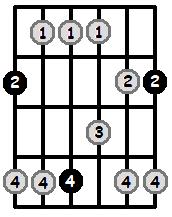
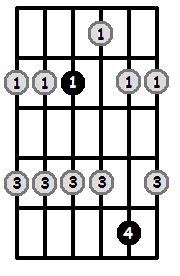
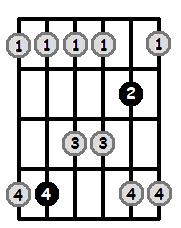
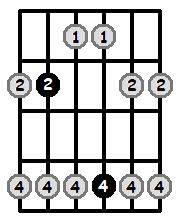

There are the 5 moveable major pentatonic positions on the guitar fretboard.
Minor Pentatonic
The minor pentatonic scale has the same interval structure as the major pentatonic scale but they are in a different order from the root note. What this effectively means is that the major and minor pentatonic scales use the same shape, but start on different notes. This will become a little more clear as we explain. Let’s look at the intervalic structure of the minor pentatonic scale:
(from root note) – minor 3rd – Tone – Tone – minor 3rd – tone
For example, a C minor pentatonic scale would look like this
(the root note is) C (up a minor 3rd to) Eb (up a tone to) F (up a tone to) G (up a minor 3rd to) Bb (up a tone back to the root note) C
C – Eb – F – G – Bb
If we analyze the scale tones of the minor pentatonic scale, we get the following:
Root – flat 3rd – 4th – 5th – flat 7th
Again, it’s a 5 note scale, and the ‘flat 3rd’ is what gives it its minor characteristic.
5 Minor Pentatonic Positions
Let’s have a look at the 5 moveable positions of the minor pentatonic scale:



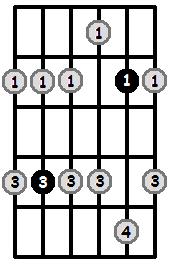

There are the 5 positions of the minor pentatonic scale.
Relative Major And Minor
As I mentioned earlier, the major and minor pentatonic scales are derived from the same set of intervals and therefor use the same shapes but with different root notes. Let’s analyze this further.
The C major pentatonic scale has the following notes:
C – D – E – G – A
The A minor pentatonic scale has the following notes:
A – C – D – E – G
As you can see, both scales contain the same notes, but the root note is different for each. This means that for every major pentatonic, there is a relative minor and visa versa. A good trick to quickly figure out the relative minor pentatonic from a major pentatonic is to go back one scale tone from the root note. For example, if we were to play Eb major pentatonic, all we would need to do to figure out the relative minor is go back one scale tone (to C) and we would know that C minor is the relative minor of Eb major. To do this the other way around, simply play a minor pentatonic and go up one scale tone. For example, if we were to play a G minor pentatonic and go up a scale tone (to Bb) we would know that Bb major is the relative major of G minor.
Lastly, let’s have a look at the shapes of two relative keys to visually demonstrate how they are related.
We could play the Ab major pentatonic scale in the first position like this:
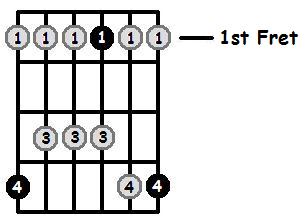
We could also play the F minor pentatonic scale (relative minor of F major) in the first position like this:
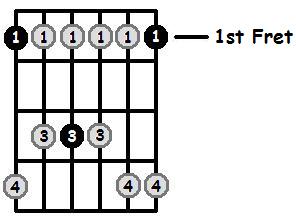
As you should be able to see, it is the same shape in the same position but the root notes have changed.
Here are links to individual keys of both major and minor pentatonic scales and their positions along the guitar fretboard:
Major Pentatonic Scales (Individual Scales)
- A Flat Major Pentatonic
- A Major Pentatonic
- A Sharp Major Pentatonic
- B Flat Major Pentatonic
- B Major Pentatonic
- C Major Pentatonic
- C Sharp Major Pentatonic
- D Flat Major Pentatonic
- D Major Pentatonic
- D Sharp Major Pentatonic
- E Flat Major Pentatonic
- E Major Pentatonic
- F Major Pentatonic
- F Sharp Major Pentatonic
- G Flat Major Pentatonic
- G Major Pentatonic
- G Sharp Major Pentatonic
Minor Pentatonic Scales (Individual Scales)
- A Flat Minor Pentatonic
- A Minor Pentatonic
- A Sharp Minor Pentatonic
- B Flat Minor Pentatonic
- B Minor Pentatonic
- C Minor Pentatonic
- C Sharp Minor Pentatonic
- D Flat Minor Pentatonic
- D Minor Pentatonic
- D Sharp Minor Pentatonic
- E Flat Minor Pentatonic
- E Minor Pentatonic
- F Minor Pentatonic
- F Sharp Minor Pentatonic
- G Flat Minor Pentatonic
- G Minor Pentatonic
- G Sharp Minor Pentatonic

I like it; I have added it to my folder of minor and major pentatonic scale exercises. Keep up the good work and rock on!